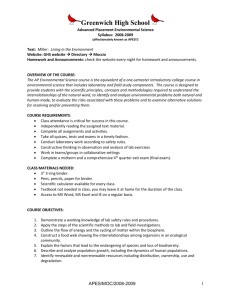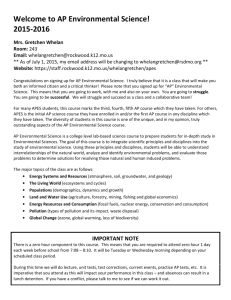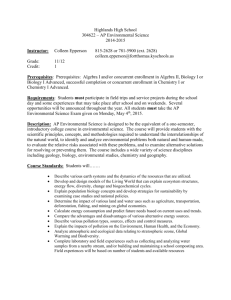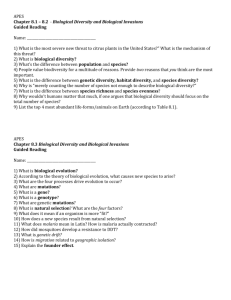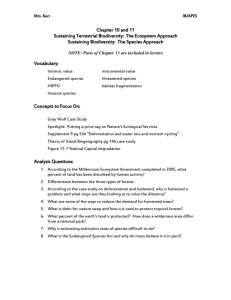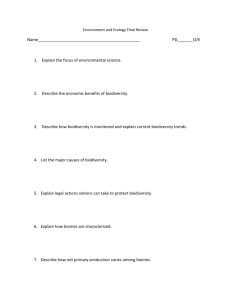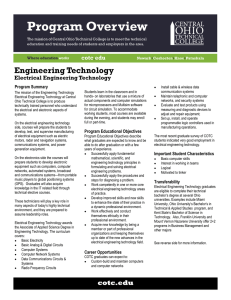AP Environmental Science Syllabus - Big Walnut Schools
advertisement
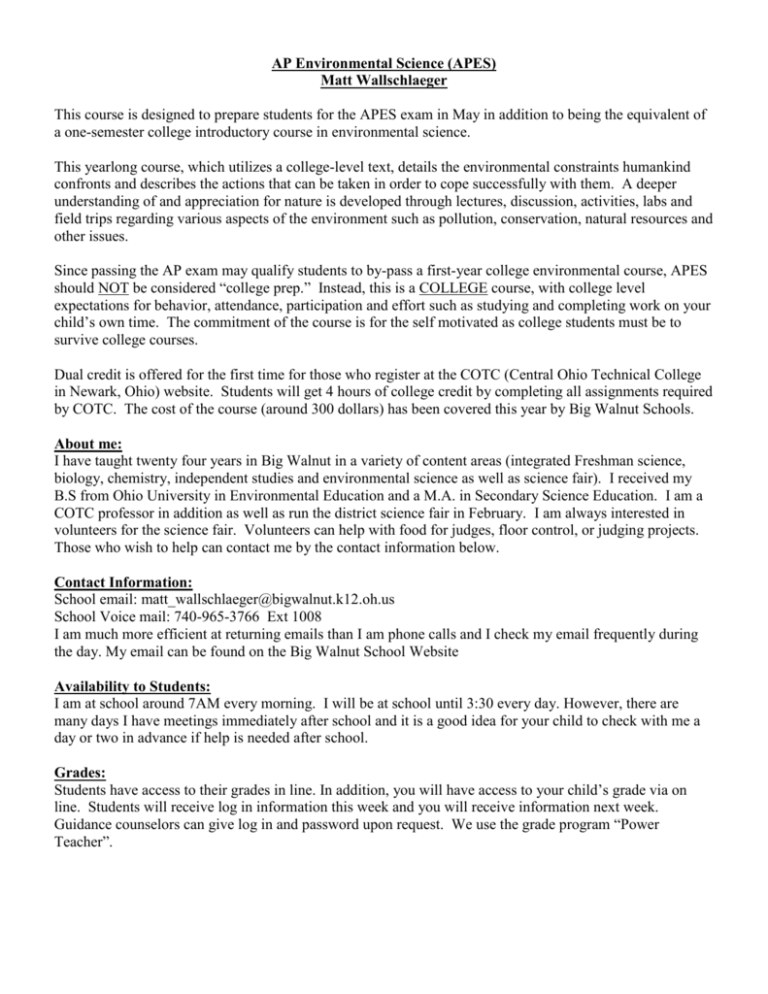
AP Environmental Science (APES) Matt Wallschlaeger This course is designed to prepare students for the APES exam in May in addition to being the equivalent of a one-semester college introductory course in environmental science. This yearlong course, which utilizes a college-level text, details the environmental constraints humankind confronts and describes the actions that can be taken in order to cope successfully with them. A deeper understanding of and appreciation for nature is developed through lectures, discussion, activities, labs and field trips regarding various aspects of the environment such as pollution, conservation, natural resources and other issues. Since passing the AP exam may qualify students to by-pass a first-year college environmental course, APES should NOT be considered “college prep.” Instead, this is a COLLEGE course, with college level expectations for behavior, attendance, participation and effort such as studying and completing work on your child’s own time. The commitment of the course is for the self motivated as college students must be to survive college courses. Dual credit is offered for the first time for those who register at the COTC (Central Ohio Technical College in Newark, Ohio) website. Students will get 4 hours of college credit by completing all assignments required by COTC. The cost of the course (around 300 dollars) has been covered this year by Big Walnut Schools. About me: I have taught twenty four years in Big Walnut in a variety of content areas (integrated Freshman science, biology, chemistry, independent studies and environmental science as well as science fair). I received my B.S from Ohio University in Environmental Education and a M.A. in Secondary Science Education. I am a COTC professor in addition as well as run the district science fair in February. I am always interested in volunteers for the science fair. Volunteers can help with food for judges, floor control, or judging projects. Those who wish to help can contact me by the contact information below. Contact Information: School email: matt_wallschlaeger@bigwalnut.k12.oh.us School Voice mail: 740-965-3766 Ext 1008 I am much more efficient at returning emails than I am phone calls and I check my email frequently during the day. My email can be found on the Big Walnut School Website Availability to Students: I am at school around 7AM every morning. I will be at school until 3:30 every day. However, there are many days I have meetings immediately after school and it is a good idea for your child to check with me a day or two in advance if help is needed after school. Grades: Students have access to their grades in line. In addition, you will have access to your child’s grade via on line. Students will receive log in information this week and you will receive information next week. Guidance counselors can give log in and password upon request. We use the grade program “Power Teacher”. Homework: If a student is absent, he/she may either refer to their calendar or make-up board in the classroom or on the On line Classroom provided by the school district. All papers are kept on file for 2 weeks (the current week and previous week). It is up to the student to get any notes or work missed to be turned it in on time for credit. Tests: Tests will be given at end of a chapter or group of chapters. This will most likely be twice a month. Tests will be worth 100 points and will consist of 20-25 multiple choice questions to be completed in 20 minutes and one free response questions to be completed in 20 minutes. This format has been chosen to mimic the AP exam. Helpful Study Tips: *Pre-read each chapter. Use post-its to mark initial information that appears important or that might be difficult to comprehend. *Complete the chapter objectives for each chapter as the reading is completed. Make sure to note material that is not understood so that it can be discussed in class. * There are online support materials, which include practice tests questions, outlines and vocabulary at http://www.highschool.bfwpub.com/Catalog/product/friedlandrelyeaenvironmentalscienceforapfriedland/studentresources that accompany the text. The text is called Environmental Science AP by Friedland. *Study a little every night….cramming for the exam is usually not the most efficient way to study for college courses. *Ask questions and seek help before it is too late. *Take the time to think about how what is being studied now is related to last week’s topics, last month’s topic and so on. To help with this be sure students are completing their weekly journal entries. *Be aware of what is going on in the world around you. How is what we are studying today being reported in the news that night? Notebooks: Student should have a three-ring binder in which they keep their work. Many colleges will require students present their notebook as well as a passing AP exam score to receive college credit for the course so a quality notebook is essential not only for success in the class but also for receiving college credit. Field Trips: There may be field trips as the year progresses but each and every one is essential to experiencing environmental science as some of the issues we will see cannot be experienced at a high school. Some of the trips may require that students return after school is dismissed. Topic Outline for APES and dual credit Bio 105 First Quarter August 22 – October 18 Introduction to Environmental Science August 23- 31 Chapter 1: Studying the State of Our Earth Chapter 2: Environmental Systems August 23-27 August 28-31 Biodiversity – The Living World September 4 - 14 September 4 - 14 Chapter 4: Global Climates and Biomes (Both Terrestrial and Aquatic) Biological and Human Population September 17 – October 18 Chapter 6: Population and Community Ecology Chapter 7: The Human Population Second Quarter September 17 – October 2 October 3 - 18 October 22 – January 17 Understanding the Hydrosphere October 22 – November 13 Chapter 9: Water Resources Chapter 14: Water Pollution October 22 - 31 November 5 - 13 Food, Soil Conservation, Pest Management and Sustaining Aquatic Biodiversity – Land Use November 14 – December 5 Chapter 11: Feeding the World November 14 - 20 Chapter 10: Land, Public, and Private November 26 – December 5 Understanding the Biosphere - The Living World December 6 - January 10 Chapter 3: Ecosystem Ecology Chapter 5: Evolution of Biodiversity Chapter 18: Conservation of Biodiversity Third quarter December 6- 12 December 13 -21 January 7 - 11 January 22 – March 22 Sustaining Key Resources - Energy resources and Consumption January 22 – February 15 Chapter 8: Earth Systems January 22 - 29 Chapter 12: Nonrenewable Resources January 30 - February 6 Chapter 13: Achieving Energy Sustainability February 7 - 15 Effects on the Environment and Sustaining Environmental Quality – Pollution February 19 – March 22 Chapter 15: Air Pollution and Stratospheric Ozone depletion February 19 – March 1 Chapter 17: Human Health and Environmental Risks March 4 - 22 Fourth quarter April 2 – June 5 Global Impacts and Sustaining Human Societies - Global Change and a Sustainable Future April 2 – April 26 Chapter 16: Waste Generation and Waste Disposal April 2 - 12 Chapter 19: Global Change April 15 - 19 Chapter 20: Sustainability, Economics and Equity April 22 - 26 April 29-May 3 May 6-10 Practicing the AP Exam AP Exam Week May 13-30 Environmental Issue Presentation Other Options: Wildlife Rehab presentation Ohio State Guest Speaker Bird House project Photovoltic lab Leaf Collection Plot Study Parent Teacher Conference Dates: Please call the high school for conference dates. Pam Ott in the main office will schedule an appointment.
